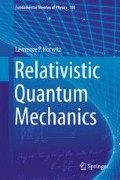Abstract
In this chapter, we shall discuss the statistical mechanics of a many event system, for which the points in space time constitute the fundamental entities for which distribution functions must be constructed to achieve a manifestly covariant theory. Assuming that each event is part of an evolving world line, as in our construction of Chap. 4. the counting of events is essentially equivalent to the counting of world lines corresponding to particles. Therefore one should expect that, as we indeed find, the statistical mechanics of events is closely related to the theory of statistical mechanics of particles, as developed, for example, in Synge (1957); see also, de Groot (1980). Hakim (2011), Israel and Kandrup (1984) stress the importance of manifest covariance. We construct a canonical Gibbs ensemble based on a microcanonical ensemble, as is usual in statistical mechanics (e.g. Huang 1967), enabling us to define a temperature and the basic thermodynamic functions (Horwitz 1981).
Access this chapter
Tax calculation will be finalised at checkout
Purchases are for personal use only
Notes
- 1.
As remarked in Chap. 2, in Galilean mechanics, due to the existence of a cohomology in the Lie algebra of the Galilean group, a definite value must be assigned to the value of the mass to achieve an irreducible representation (Sudarshan 1974).
- 2.
It was shown by Horwitz and Rotbart (1981a), by examining the scalar product, that the nonrelativistic limit of the relativistic quantum theory is obtained systematically in this way as well.
- 3.
Since the sign of the energy of the antiparticle is opposite to that of the particle, the chemical potential \(\mu \) must change sign for the antiparticle, but the mass squared of both particle and antiparticle are positive, and therefore the sign of \(\mu _K\) does not change.
- 4.
It was suggested by Andrew Bennett (private communication) that the concatenated field equations, corresponding to an integral over \(\tau \) would equivalently lead to this result.
Author information
Authors and Affiliations
Corresponding author
Rights and permissions
Copyright information
© 2015 Springer Science+Business Media Dordrecht
About this chapter
Cite this chapter
Horwitz, L.P. (2015). Relativistic Classical and Quantum Statistical Mechanics and Covariant Boltzmann Equation. In: Relativistic Quantum Mechanics. Fundamental Theories of Physics, vol 180. Springer, Dordrecht. https://doi.org/10.1007/978-94-017-7261-7_10
Download citation
DOI: https://doi.org/10.1007/978-94-017-7261-7_10
Published:
Publisher Name: Springer, Dordrecht
Print ISBN: 978-94-017-7260-0
Online ISBN: 978-94-017-7261-7
eBook Packages: Physics and AstronomyPhysics and Astronomy (R0)

